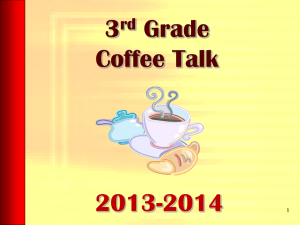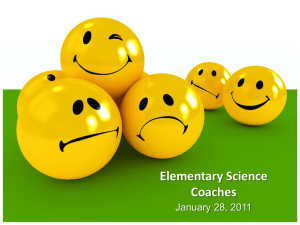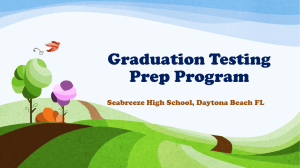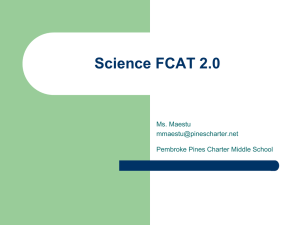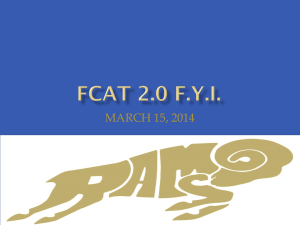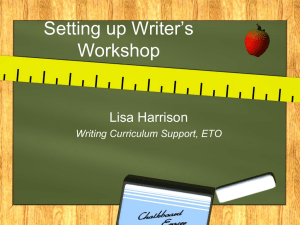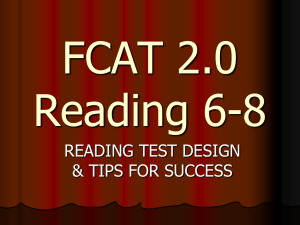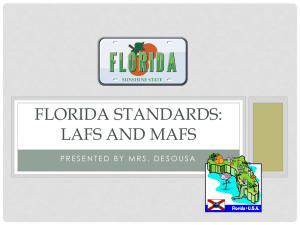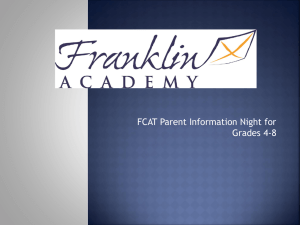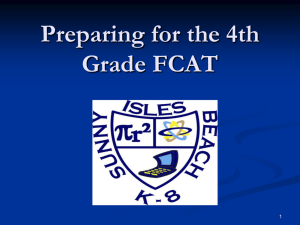Click here to the FCAT the PowerPoint
advertisement
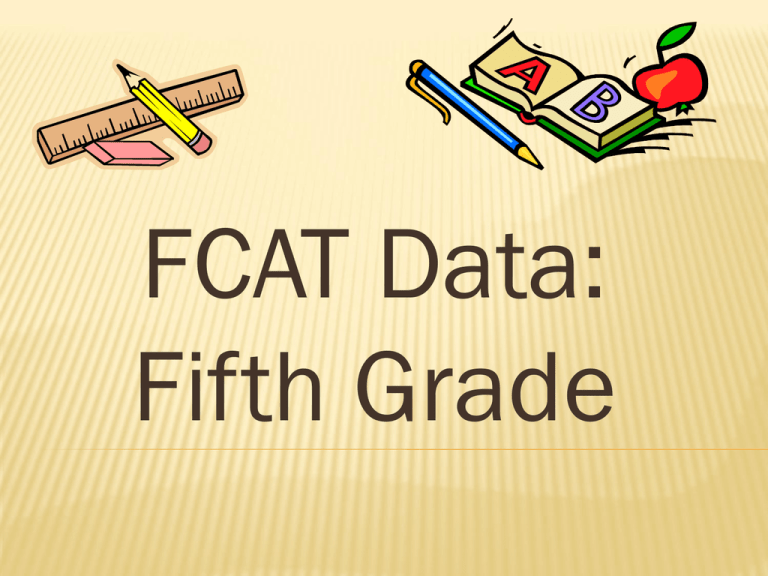
FCAT Data: Fifth Grade Math and Science MATH/SCIENCE INTERIM ASSESSMENTS The Math and Science interims are an integrated assessment designed to help monitor students’ attainment of the benchmarks. Students take a Baseline at the beginning of the year, a Fall and Winter Interim and a post-test. The Math interim assesses benchmarks only taught during the 9 weeks. Different benchmarks are assessed each 9 weeks. The Science interim assesses ALL Science benchmarks taught throughout the year. MATH YEAR-AT-A-GLANCE 1st Nine Weeks 2nd Nine Weeks 3rd Nine Weeks 4th Nine Weeks Place Value and Multiplication Graphs and Data Measurement FCAT 2.0 Crunch Time Division with One- and TwoDigit Divisors Order of Operations and Equations Integers Fractions Decimals 2-Dimensional Multiplication and 3and Division of Dimensional Decimals Figures Area and Volume Multiplication and Division of Fractions MATH Must Know in Math MULTIPLICATION / DIVISION FACTS EQUATIONS **FRACTIONS** MEASUREMENT AND GEOMETRY **SOLVING REAL-WORLD WORD PROBLEMS** SCIENCE YEAR-AT-A-GLANCE 1st Nine Weeks 2nd Nine Weeks 3rd Nine Weeks 4th Nine Weeks Science Process Skill / Scientific Method Forms of Energy Earth Systems and Patterns Human Body Properties of Matter Energy Transfer Heredity and Reproduction FCAT 2.0 Crunch Time Changes in Matter Earth in Space and Time Interdependence of Organisms Forces and Changes in Motion Earth Structures SCIENCE Must Know in Science **SCIENTIFIC METHOD** (Problem Statement, Background Research, Using and citing Resources, Understanding Controls and Variables, etc.) **SCIENCE PROCESS SKILLS** (ie: Observation, Interpreting Data, Inferencing, etc.) ONLINE RESOURCES http://www.hmhco.com/gomathacademy/ https://www.khanacademy.org/ http://www.fcatexplorer.com/ https://www-k6.thinkcentral.com/ePC/start.do http://studyjams.scholastic.com/studyjams/index.htm http://www.explorelearning.com/ Reading ACCELERATED READER AR is a computerized reading test that monitors independent reading levels AR tests are to be taken on a regular basis Students are required to earn a certain amount of points for each 9 weeks Students must earn 85% or above to be considered proficient Students should check out both fiction and non-fiction books STAR READING STAR Reading is a comprehensive computerized reading assessment that adjusts the questions’ complexity based on student’s answers Students take the STAR Reading test every 9 weeks to monitor progress STAR Reading Growth Reports show the increments of progress and grade level in which the child can read independently. READING INTERIM The Reading interims are an integrated assessment designed to help monitor students’ attainment of the benchmarks. Students take a Baseline at the beginning of the year, a Fall and Winter Interim and a post-test. The Reading Interim assesses ALL Reading benchmarks taught throughout the year. What can you do to help your child? Check your child’s AR Level - it should be on a 5th grade level Check homework for strategies Check agendas for notes PURPOSE OF THE FCAT 2.0 Parents, students, and teachers need FCAT data to provide information about the students’ mastery of skills. The utilization of the data by the public to understand the “educational health” of students and to hold schools and districts accountable for student progress. READING ASSESSMENT Fifth Grade FCAT 2.0 70-Minute Session Each Day REPORTING CATEGORIES FCAT 2.0 Vocabulary Reading Application Literary Analysis (Fiction/Nonfiction) Informational Text, Research Process FCAT 2.0 READING CONTENT Vocabulary Reading Application Literary Analysis Informational Text Meaning of Words in Context Main Idea Use of Comparison and Contrast Organization & interpretation of information Word Analysis Supporting Details Cause and Effect Relationship Chronological Order Similarities and Differences Among Characters, Setting and Events Author’s Purpose in a Simple Plot Development & Conflict Resolution FCAT 2.0 READING CONTENT Vocabulary Main Idea / Relevant Details / Chronological Order Meaning of words in context Main idea / Message Analyze words in text Relevant details Multiple meanings Synonym / Antonym Prefixes / Suffixes Affixes / Base words Root words Chronological order Conclusions / Inferences Compare and Contrast Use of comparison & contrast Similarities & differences among topics, characters, problems, settings and events Within/across text Cause and Effect Cause/effect of an action or event in fiction, non-fiction, poetry or drama FCAT 2.0 READING CONTENT Author’s Purpose and Perspective Text Structures / Organizational Patterns author’s purpose in a simple text plot how a passage, article, text is organized (compare and contrast / cause and effect / chronological order / description) author’s point of view author’s main message / mood/ interpretation Theme / Topic Elements of Story Structure central message of the passage / article / text plot development / problem / resolution what best lesson can be learned from this passage character development within/across text character point of view FCAT 2.0 READING CONTENT Descriptive / Idiomatic and Figurative Language what mood does the author create idioms Text Features in Literary Text what best describes illustration the in passage, article, text metaphors onomatopoeia alliteration simile purpose of illustration charts, headings captions, graphs diagrams, maps hyperbole personification Locate/Interpret/ Organize Information/Text Features in Informational Text titles, keys, legends & stanzas locate , interpret & organize information Purpose of: headings/subheadings maps titles footnotes checkmarks Validity & Reliability (5th grade only) evaluating text making judgments about how correct the information is: can you support where information is coming from what is the most valid argument illustrations / captions what evidence shows support charts graphs/ legends/keys within/across text diagrams FCAT REPORTING CATEGORIES FOR READING Grades Vocabulary Reading Application Literary Analysis Informational Text 3-5 15-25% 25-35% 25-35% 15-25% 50% will be Informational Text and 50% will be Literary Literary passages provide entertainment or inspiration and include fiction, nonfiction, poetry, and drama. Informational passages are subject-matter centered and the language may be used to solve problems, raise questions, provide information, or present new ideas. The context of these passages includes everyday life outside of the classroom. Fiction Short Stories Poetry Historical Fiction Fable Non-Fiction Biographical and autobiographical sketchers Diaries, memories, journals and Folk Tales & Tall Tales Legends Myths Fantasy Drama Excerpts form longer works letters Essays (personal and classical narratives Critiques TYPES OF LITERARY TEXT Primary Sources/Nonfiction • Historical documents • Essays • Letters, journals and diaries Secondary Sources/Nonfiction • Magazine articles • Newspaper articles • Editorials • Encyclopedia articles Functional Materials • Consumer Documents (warranties, manuals, contracts, applications) Embedded in text (tables, charts, maps, graphs, illustrations, photographs, captions, text boxes) TYPES OF INFORMATIONAL TEXT FCAT 2.0 PREPARATION Focus Calendars Differentiated Instruction Learning Centers Weekly Benchmark Testing District Interim Assessments FCAT Task Cards Aligned with the NGSSS Tutoring Program TECHNOLOGY RESOURCES FOR FCAT 2.0 PREPARATION Technology Program Identified Grade Level Usage Time Success Maker (Reading / Mathematics) Grades 3-5 Within the instructional school day Reading Plus Grades 2-5 At home Ticket to Read K-5 At home FCAT Explorer 4-6 At home Accelerated Reader 1-5 At least 30 minutes of reading at home (THEY SHOULD BE READING ON GRADE LEVEL) SMART SEVEN STRATEGIES Step 1: Read and Box the title. Step 2: Number the paragraphs and/or text features. Step 3: Read each paragraph and/or text feature. Stop and think about what you’ve read. Write 1 to 3 key words in the margin for each paragraph. Step 4: Read each question and underline 1 to 3 key words that \connect back to the text. Step 5: Read each answer and put or beside each answer choice. Step 6: Prove your answer. Step 7: Mark your answer. WEBSITES TO UTILIZE AT HOME Reading Plus (login.readingplus.com) FCATExplorer.com Readworks.org Freerice.com Sadlier-oxford.com/vocabulary
